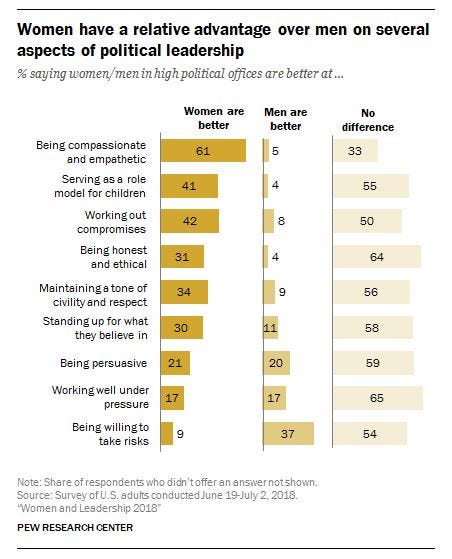By Kent R. Kroeger (Source: NuQum.com; January 12, 2019)
A year ago I wrote an article on the dearth of female Republicans in national elected office, particularly the U.S. House. [The original article is here.]
The article’s gist was that if Republicans don’t nominate more women against incumbent Democrats, the party’s decline (starting in the 2018 midterms) will be precipitous.
The GOP lost 40 U.S. House seats in 2018 (one seat in North Carolina is still to be determined).
In the 115th Congress, there were 21 Republican women. In the new 116th Congress there are only 13. In comparison, the number of Democratic women in the House went from 64 to 89.
If trends continue, half of all U.S. House members will be women by 2032 and not one will be a Republican.
Of course, that will never happen, right? The Republicans will adjust, right?
Do Republicans realize it is an empirical fact that women are widely viewed as more honest, empathetic and trustworthy (see Figure 1)? Do Republicans understand that, if those attributes become central to vote decisions in the future, their party is screwed?
Figure 1: Public opinion on gender differences in political leadership

Why is the number of GOP women in the U.S. House dropping?
Perry Bacon Jr. from FiveThirtyEight.com highlighted last year some of the barriers preventing more Republican women from winning elections and staying in office, not the least of which is that Republican women tend to be more moderate (or are perceived to be more moderate) than their Republican male counterparts. And as Republican voters have drifted right ideologically, women Republicans have found it more difficult to survive the nomination process. Likewise, a significant percentage of incumbent Republican women (usually moderates) have voluntarily left office knowing their re-election chances were increasingly doubtful.
Other possible reasons for the GOP’s lack of elected women include:
(1) The Democrats being viewed as the party of women’s rights,
(2) There are more Democratic women with the backgrounds typically associated with political careers, and
(3) The money is more likely to flow to Democratic women running for office than it is to Republican women.
While all of the barriers are potentially true, they do not dictate that Republican women will vanish from the political landscape.
Successful parties adjust to changing electorates. The Democrats moved to the right under Bill Clinton and the Republicans will inevitably adjust in the current political environment.
And even if the Republicans don’t move towards the center, its not like there aren’t strong conservative women out there capable of running for Congress. This is not a supply problem. The GOP has an old, white men leadership problem.
What holds the Republican Party back from nominating more women is a Republican hierarchy that fails to appreciate the competitive necessity of introducing more diversity into the party’s primary races.
To be sure, simply nominating women is not, in and of itself, a solution to the GOP’s gender (and diversity) problem. For the sake of argument, let us assume in the 2018 midterms the GOP had nominated a woman in races where there was a male nominee,And assume also that this would have added one percent to the GOP’s vote total in those races. Across the 435 U.S. House races in the 2018 midterms, that would have changed the outcome in the GOP’s favor in only six House races (CA21, FL26, ME2, NJ3, OK5, VA7).
New York Representative Elise Stefanik calls the GOP gender problem a “crisis”
Former head of candidate recruitment for the National Republican Congressional Committee (NRCC), New York Rep. Elise Stefanik, resigned from that position after the 2018 midterms out of frustration that the Republican Party, by policy, does not get involved in the primary process (unlike the Democrats).
Stefanik will instead work through her leadership PAC to recruit, train and cultivate women GOP candidates during the primary races.
“If that’s what Elise wants to do, then that’s her call, her right,” NRCC chairman Tom Emmer (R-MN) told Roll Call last November. “But I think that’s a mistake. It shouldn’t be just based on looking for a specific set of ingredients — gender, race, religion — and then we’re going to play in the primary.”
But Republican leaders like Emmer, thinking Stefanik’s efforts represent a capitulation to identity politics, are actually ensuring identity politics’ role in electoral politics.
For Republicans, the first line of defense in combating the divisiveness of identity politics is to have leaders drawn from all backgrounds. Now is not the time to become more white and more male.
To do that, Republican leaders and voters alike need to understand that photos like this one from a 2017 Republican press conference in the Rose Garden don’t just create bad optics, they represent a losing brand of politics.

Just as Chuck Schumer and Nancy Pelosi cannot be the face of the Democratic Party much longer, Mitch McConnell and Lindsay Graham cannot be the brand leaders for the Republicans anymore.
Nikki Haley. Mia Love. Joni Ernst. Elise Stefanik. Kristi Noem. Kirstjen Nielsen. Kim Reynolds. The talent pool is out there for the Republicans. Seek their counsel. Learn from them. Put them in leadership positions so they are part of the GOP’s public face.
And it’s not about gender or youth. Bernie Sanders is not young yet still relevant. It is about fitting in and being able to lead within the current zeitgeist.
And this environment trends female and puts a premium on empathy, trust and honesty. And that does not necessitate the systematic exclusion of men, who are fully capable of such qualities. But it does mean the Republican Party must address its gender crisis.
Wake up GOP. Listen to Elise Stefanik.
- K.R.K.
